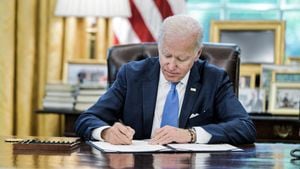On November 20, 2024, the conflict between Ukraine and Russia escalated dramatically as Ukraine launched U.K.-made Storm Shadow missiles deep within Russian territory. This event marked the first known use of these missiles against Russia, coinciding with another significant development—the previous day's firing of U.S.-made ATACMS missiles by Ukraine across its border.
The timing of Ukraine's actions aligns with reports of over 10,000 North Korean troops being deployed along the Russian border. This troop movement raised alarms among Western officials, prompting fears of intensified hostilities as Russia mobilizes additional resources. The UK's Defense Minister confirmed the approval of using Storm Shadow missiles for strikes beyond Ukrainian soil, acting as part of Ukraine's response to aggression.
According to various sources, including Russian military channels and media reports, up to twelve Storm Shadow missiles targeted the Kursk region, with claims stating they hit strategic installations. Imagery shared by pro-Russian bloggers indicated missile fragments from the attack, heightening speculation about the nature of the strikes and their intended targets.
Ukrainian officials have utilized these strikes to assert their capability to retaliate against Russian aggression. Defense Minister Rustem Umerov commented during a press conference, "We are using all means to defend our country, so we won't gointo detail. But we are just sending the message—we are capable and able to respond." This express determination reveals Ukraine's growing reliance on advanced weaponry from Western allies amid the shifting tide of war.
Despite the lack of direct confirmation from UK officials surrounding the strike specifics, various media reports and statements from military experts seem to validate the usage of the missiles. Military analysts point out the significance of Storm Shadow missiles, which possess precision targeting capabilities aimed at fortified structures, such as command posts and ammunition depots, making them integral to Ukraine's military strategy.
The missiles, capable of reaching targets up to 250 kilometers away, have raised the stakes of the conflict significantly. Russian military responses have been swift, with statements from the Defense Ministry indicating they intercepted some missiles but confirming at least two penetrated their air defenses. The Kremlin's spokesman warned these actions would lead to escalated consequences.
While the attacks signify Ukraine's commitment to mounting counter-offensives against Russian military positions, they also invoke fears of retaliation from Moscow. Reports about Russia preparing for broader assaults on Ukrainian infrastructure and even threatening hybrid warfare tactics against NATO allies have emerged, contributing to the tense geopolitical atmosphere.
President Putin's administration has framed these missile launches as provocations, asserting such actions would force Russia to reconsider its military posture significantly. Amid these developments, Eastern Europe has geared up for intensified conflict, exhibiting premature signs of societal anxiety as civilians adapt to the new reality of heightened military readiness.
While the world watches, the conflict's unpredictable nature leaves regional actors and global leaders wrestling with the possibility of direct confrontations, whereby NATO's involvement could trigger broader calamity—something analysts have hinted at as the rhetorical volleys continue between capitals. The US has reiterated its commitment to supporting Ukraine but has maintained its military assets would remain solely for defensive purposes.
The situation remains fluid as the day-to-day reality for Ukrainians intertwines military tactics with civilian life, demonstrating resilience in the face of adversity. Amid the exchanges of military might, Ukraine's leadership continues to urge Western nations to respond effectively against Russian aggression.
With the backdrop of impending winter and worsening humanitarian conditions, Ukraine's missile strategy poses both immediate risks and long-term consequences for future diplomatic relations and stability across the region. The question looms large—even as both sides brace for potential escalations, how much longer will the world hold its breath as Ukraine asserts its right to retaliate, aided by cutting-edge technology?



